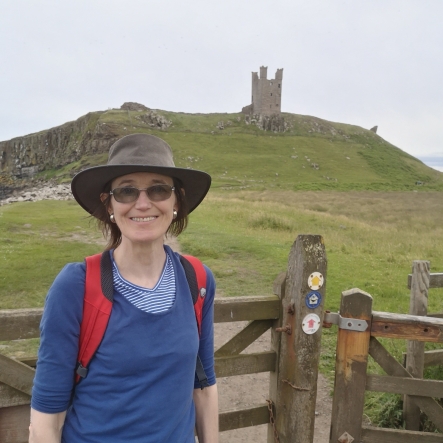Back in 2003-4, the brilliant BBC radio producer Julian May and I made a half-hour poem for BBC Radio 4 called Dunstanburgh Castle: a secret as old as the stones. I’ve always loved Dunstanburgh Castle on the Northumberland coast. It’s a ruin; not grand and inhabited like Bamburgh or Alnwick castle, but somehow in spring and summer – its cliffs populated by boisterous kittiwakes, its towers teeming with swallows and its acres of grassland blooming with wildflowers and moths – it is more alive than any human habitation. It is not accessible by road; you reach it by a half hour hike over fields or, from the north, across the sandy sweep of Embleton Bay. And it’s a mysterious place. A ruin on a high, black, basalt cliff, it stands alone, windswept, visible for miles around, the sea breaking at its foot. What is it doing there, so far from any settlement?
My idea was to write a history of the castle, human and natural. I wanted to write about it over the course of a year, tracing the seasonal changes in its wildlife and weather – things which would have been much the same when it was built in 1313. The idea was to summon ‘voices’ from its past, from the years when it offered shelter to local people from Scots raiders, or stood as an advertisement for the ‘good lordship’ of its creator, Thomas of Lancaster. It seems that Thomas built Dunstanburgh at least partly as visual propaganda – as an advertisement for his ability to provide justice and protection in a lawless country close to the Border, in rivalry to an ineffectual King. Surrounded by man-made ‘meres’, the castle referenced King Arthur’s Camelot – a subversive suggestion of entitlement to the throne within sight of the royal castle at Bamburgh.
Last month I revisited Dunstanburgh with another fantastic radio producer, Adam Fowler. Adam was making a programme called Fence Me In, in which he investigates how the acoustics of a space affect artists’ creativity. We talked about the varied spaces within and outside the ruin – from the imposing drum towers to tiny garderobes, to the 30-metre high basalt cliff on the castle’s north side – and about how I tried to evoke those spaces in the sound of words.
I wrote Dunstanburgh over the course of a year, during which I made many hours of audio recordings. Those recordings were often the starting-point for particular parts of the poem. Bursts of swallow-song in the drum towers gave rhythm and colour to one section. The pulse of seas breaking in a rocky inlet called the Egyncleugh punctuated another. Line-length, stanza form and rhythm were strongly shaped by the enclosed or open acoustics of spaces.
When Julian May and I recorded the poem on location, together with actor Trevor Fox, on a sleety February day in 2004, we tried to realise this mimesis by performing the poem in the actual spaces which had shaped it. So Trevor read the Egyncleugh section down among the rocks where the sea was breaking. It was reassuring to discover that the section I had written six months earlier still faithfully imitated the rhythm of the sea’s pulse. When I revisited the site with Adam Fowler more than 15 years later, that was still the case.
One thread that runs through the half hour poem is a chant, which alludes to the local folkloric story of Sir Guy the Seeker. Sir Guy arrives at the castle one stormy night, to be led down a staircase where he is shown the figure of a girl trapped inside a crystal. To release her, he must make a choice between a sword and a bugle. Sir Guy makes the wrong choice. I conflated this story with other folklore about the ghost of a child haunting the cliff, and wrote a chant which evokes the otherworldly, echoing sound of the city of kittiwakes on the ancient, shadowy basalt cliff beneath the castle. Julian May and I then recorded children from Seahouses First School reading that chant, and merged their voices with those of real kittiwakes recorded at the castle. The result both evokes that particular place in space and time, and paradoxically also gives a sense of timelessness.
I think of writing poetry as an act of listening. It can feel as if one is trying to translate an emotional resonance into actual physical sound architecture – as if one could turn an emotion into a place, something that could be revisited at any time. In the case of Dunstanburgh, I thought of it as a synaesthetic attempt to translate a place which spoke to all my senses into sound, both on the level of words, and as actual sound in the radio poem. Julian May and I worked together to weave the sounds I had collected over the year back into the recorded poem in the studio. You can hear the result as part of the eBook version of my Bloodaxe poetry collection, Two Countries, available HERE.
The full text of Dunstanburgh is published in Two Countries (Bloodaxe Books, 2014), available HERE.
Adam Fowler’s programme, Fence Me In, about the affects of the acoustics of a space on creativity, also features musicians Anna Clock and Ailbhe Nic Oireachtaigh, director Catherine Alexander of Complicité Theatre Company, and Chris Chafe of Stanford University. It is broadcast on BBC Radio 4 on Sunday August 4th at 13.30, and afterwards on BBC Sounds. You can read about it — and listen after broadcast — HERE.
For Katrina Porteous and Alexis Bennett in Dartington Great Hall 2019, please click HERE.

Katrina at Dunstanburgh 2019 – photo by Adam Fowler
